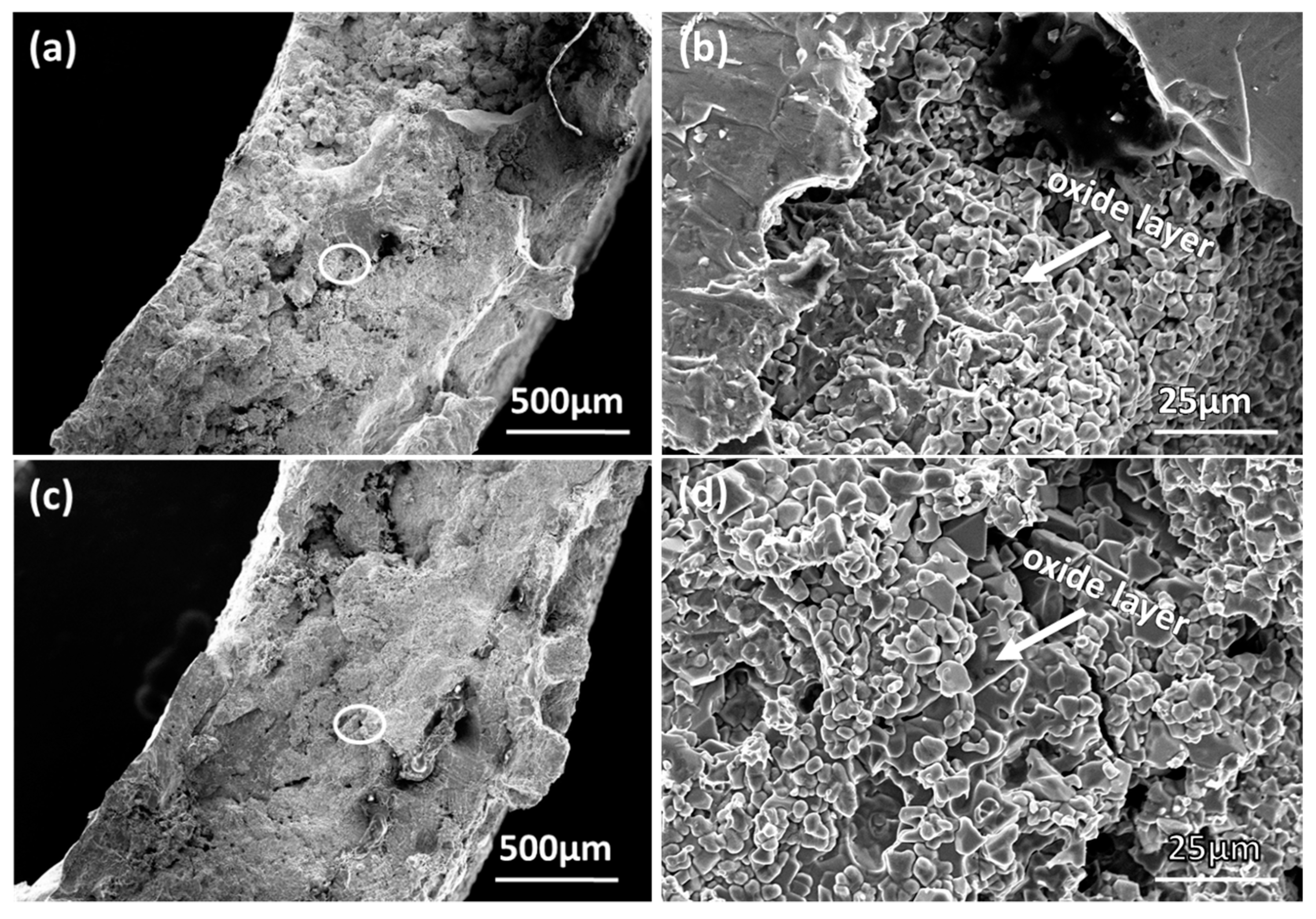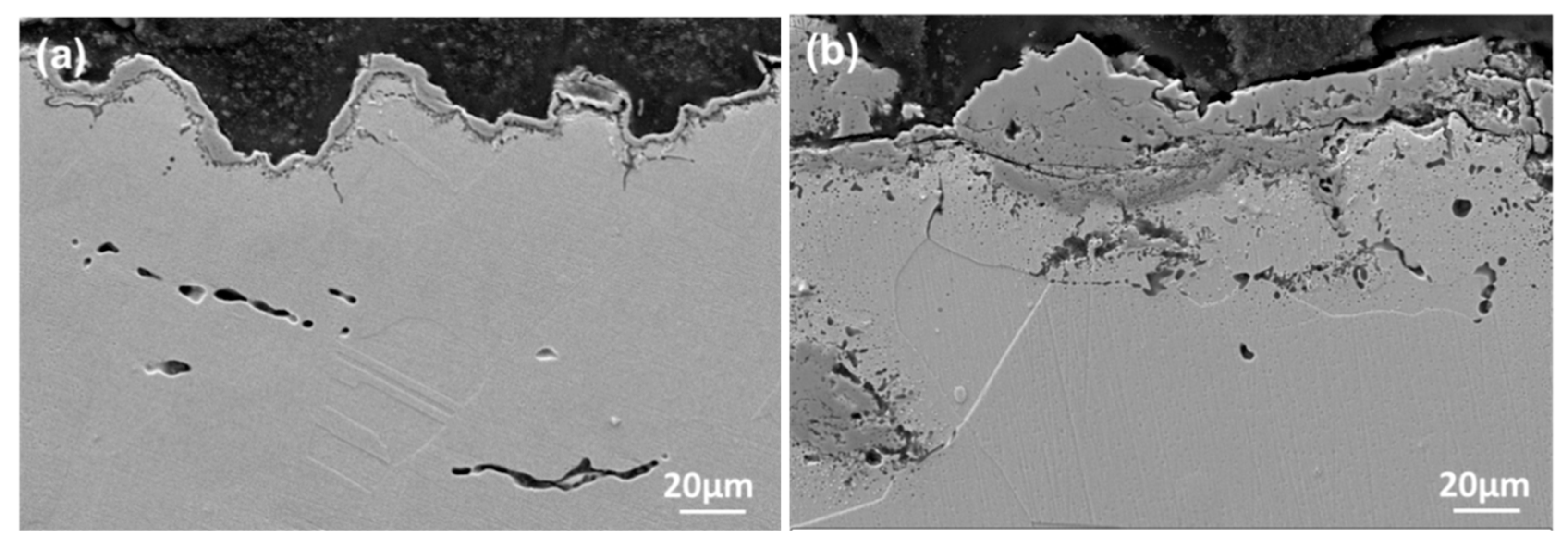Thermal Fatigue Characteristics of Type 309 Austenitic Stainless Steel for Automotive Manifolds
Abstract
:1. Introduction
2. Materials and Methods
3. Results
3.1. High Temperature Strength and Thermal Fatigue Properties
3.2. Microstructure Evolutions
3.3. Fractographic Appearances
3.4. High Temperature Oxidation
3.5. SEM Surface Morphologies
4. Discussion
4.1. Crack Initiation and Propagation
4.2. Effect of Tmax on the Thermal Fatigue Life
5. Conclusions
- (1)
- As Tmax changes from 800 to 900 °C, the high-temperature tensile strength and thermal fatigue life of 309 SS decrease greatly, with a reduction of about 37.7% and 56.6%, respectively.
- (2)
- After the thermal fatigue tests, the failure specimens show the micro-voids coalescence fracture caused by the creep in the Tmax-holding processes, and the quasi-cleavage feature appears as Tmax decreases from 900 to 800 °C.
- (3)
- The fatigue cracks mainly initiate and propagate along the grain boundary regions with the formation of cavities. The defective oxide layers formed in the cracks will facilitate the propagation during the thermal cycles.
- (4)
- With the increase of Tmax from 800 to 900 °C in the cyclic tests, the effects of high-temperature strength, grain growth, creep and oxidation are enhanced together, resulting in the accelerated thermal fatigue failure of 309 SS.
- (5)
- As far as the higher maximum service temperature of automotive manifolds is concerned, it is an important direction to improve the thermal fatigue lives of stainless steels by increasing their high-temperature strength and oxidation resistance.
Author Contributions
Funding
Acknowledgments
Conflicts of Interest
References
- Liu, T.; Chen, L.; Bi, H.; Che, X. Effect of Mo on high-temperature fatigue behavior of 15CrNbTi ferritic stainless steel. Acta Metall. Sin. 2014, 27, 452–456. [Google Scholar] [CrossRef]
- Shelef, M.; McCabe, R.W. Twenty-five years after introduction of automotive catalysts: What next? Catal. Today 2000, 62, 35–50. [Google Scholar] [CrossRef]
- Ota, H.; Nakamura, T.; Maruyama, K. Effect of solute atoms on thermal fatigue properties in ferritic stainless steels. Mater. Sci. Eng. A 2013, 586, 133–141. [Google Scholar] [CrossRef]
- You, X.M.; Jiang, Z.H.; Li, H.B. Ultra-Pure Ferritic Stainless Steels—Grade, Refining Operation, and Application. J. Iron Steel Res. Int. 2007, 14, 24–30. [Google Scholar] [CrossRef]
- Ramesh, M.; Leber, H.J.; Janssens, K.G.; Diener, M.; Spolenak, R. Thermomechanical and isothermal fatigue behavior of 347 and 316L austenitic stainless tube and pipe steels. Int. J. Fatigue 2011, 33, 683–691. [Google Scholar] [CrossRef]
- Dewa, R.T.; Park, J.H.; Kim, S.J.; Lee, S.Y. High-Temperature Creep-Fatigue Behavior of Alloy 617. Metals 2018, 8, 103. [Google Scholar] [CrossRef]
- Su, C.Y.; Zhou, C.Y.; Lu, L.; Li, J.; Sun, P.Y.; He, X.H. Effect of Temperature and Dwell Time on Fatigue Crack Growth Behavior of CP-Ti. Metals 2018, 8, 1031. [Google Scholar] [CrossRef]
- Holdsworth, S. Creep-fatigue failure diagnosis. Materials 2015, 8, 7757–7769. [Google Scholar] [CrossRef]
- Liu, D.; Pons, D. An Explicit Creep-Fatigue Model for Engineering Design Purposes. Metals 2018, 8, 853. [Google Scholar] [CrossRef]
- Liu, D.; Pons, D.J.; Wong, E.H. The unified creep-fatigue equation for stainless steel 316. Metals 2016, 6, 219. [Google Scholar] [CrossRef]
- Sarkar, A.; Nagesha, A.; Parameswaran, P.; Sandhya, R.; Mathew, M.D. Transition in failure mechanism under cyclic creep in 316LN austenitic stainless steel. Metall. Mater. Trans. A 2014, 45, 2931–2937. [Google Scholar] [CrossRef]
- Kang, G.; Dong, Y.; Wang, H.; Liu, Y.; Cheng, X. Dislocation evolution in 316L stainless steel subjected to uniaxial ratchetting deformation. Mater. Sci. Eng. A 2010, 527, 5952–5961. [Google Scholar] [CrossRef]
- Fatemi, A.; Yang, L. Cumulative fatigue damage and life prediction theories: A survey of the state of the art for homogeneous materials. Int. J. Fatigue 1998, 20, 9–34. [Google Scholar] [CrossRef]
- Pegues, J.W.; Shao, S.; Shamsaei, N.; Schneider, J.A.; Moser, R.D. Cyclic strain rate effect on martensitic transformation and fatigue behaviour of an austenitic stainless steel. Fatigue Fract. Eng. Mater. Struct. 2017, 40, 2080–2091. [Google Scholar] [CrossRef]
- Cruchley, S.; Li, H.Y.; Evans, H.E.; Bowen, P.; Child, D.J.; Hardy, M.C. The role of oxidation damage in fatigue crack initiation of an advanced Ni-based superalloy. Int. J. Fatigue 2015, 81, 265–274. [Google Scholar] [CrossRef]
- Kitaguchi, H.S.; Li, H.Y.; Evans, H.E.; Ding, R.G.; Jones, I.P.; Baxter, G.; Bowen, P. Oxidation ahead of a crack tip in an advanced Ni-based superalloy. Acta Mater. 2013, 61, 1968–1981. [Google Scholar] [CrossRef]
- Pfaendtner, J.A.; McMahon Jr, C.J. Oxygen-induced intergranular cracking of a Ni-base alloy at elevated temperatures—An example of dynamic embrittlement. Acta Mater. 2001, 49, 3369–3377. [Google Scholar] [CrossRef]
- Faivre, L.; Santacreu, P.O.; Acher, A. A new ferritic stainless steel with improved thermo-mechanical fatigue resistance for exhaust parts. Mater. High Temp. 2013, 30, 36–42. [Google Scholar] [CrossRef]
- Wei, Z.; Konson, D.; Yang, F.; Luo, L.; Lin, B.; Ellinghaus, K.; Pieszkalla, M. Thermal fatigue resistance characterization and ranking of materials using the V-shape specimen testing method. Fatigue Fract. Eng. Mater. Struct. 2014, 37, 897–908. [Google Scholar] [CrossRef]
- Avery, K.; Pan, J.; Engler-Pinto, C.C.; Wei, Z.; Yang, F.; Lin, S.; Konson, D. Fatigue Behavior of Stainless Steel Sheet Specimens at Extremely High Temperatures. SAE Int. J. Mater. Manuf. 2014, 7, 560–566. [Google Scholar] [CrossRef]
- Chinouilh, G.; Santacreu, P.O.; Herbelin, J.M. Thermal Fatigue Design of Stainless Steel Exhaust Manifolds; SAE Technical Paper; SAE International: Troy, MI, USA, 2007. [Google Scholar]
- Yu, H.Y.; Lee, S.M.; Nam, J.H.; Lee, S.J.; Fabrègue, D.; Park, M.H.; Lee, Y.K. Post-uniform elongation and tensile fracture mechanisms of Fe-18Mn-0.6C-xAl twinning-induced plasticity steels. Acta Mater. 2017, 131, 435–444. [Google Scholar] [CrossRef]
- Shankar, V.; Yadav, S.D.; Mariappan, K. Influence of W and effect of loading mode on the substructural evolution of reduced activation ferritic/martensitic (RAFM) steels. Mater. Lett. 2019, 234, 257–260. [Google Scholar] [CrossRef]
- Smith, E.; Barnby, J.T. Nucleation of grain-boundary cavities during high-temperature creep. Met. Sci. J. 1967, 1, 1–4. [Google Scholar] [CrossRef]
- Lindstedt, U.; Karlsson, B.; Nystr, M. Small fatigue cracks in an austenitic stainless steel. Fatigue Fract. Eng. Mater. Struct. 1998, 21, 85–98. [Google Scholar] [CrossRef]
- Jiang, Q.C.; Sui, H.L.; Guan, Q.F. Thermal fatigue behavior of new type high-Cr cast hot work die steel. ISIJ Int. 2004, 44, 1103–1107. [Google Scholar] [CrossRef]
- Smith, E. The formation of a cleavage crack in a crystalline solid—I. Acta Metall. 1966, 14, 985–989. [Google Scholar] [CrossRef]
- Fujita, N.; Ohmura, K.; Yamamoto, A. Changes of microstructures and high temperature properties during high temperature service of Niobium added ferritic stainless steels. Mater. Sci. Eng. A 2003, 351, 272–281. [Google Scholar] [CrossRef]








| C | Si | Mn | P | Cr | Ni | Cu | Mo | Nb | N | Fe |
|---|---|---|---|---|---|---|---|---|---|---|
| 0.068 | 1.65 | 1.27 | 0.02 | 20.54 | 11.34 | 0.02 | 0.04 | 0.021 | 0.0646 | Balance |
© 2019 by the authors. Licensee MDPI, Basel, Switzerland. This article is an open access article distributed under the terms and conditions of the Creative Commons Attribution (CC BY) license (http://creativecommons.org/licenses/by/4.0/).
Share and Cite
Zhan, J.; Li, M.; Huang, J.; Bi, H.; Li, Q.; Gu, H. Thermal Fatigue Characteristics of Type 309 Austenitic Stainless Steel for Automotive Manifolds. Metals 2019, 9, 129. https://doi.org/10.3390/met9020129
Zhan J, Li M, Huang J, Bi H, Li Q, Gu H. Thermal Fatigue Characteristics of Type 309 Austenitic Stainless Steel for Automotive Manifolds. Metals. 2019; 9(2):129. https://doi.org/10.3390/met9020129
Chicago/Turabian StyleZhan, Jianming, Moucheng Li, Junxia Huang, Hongyun Bi, Qian Li, and Hui Gu. 2019. "Thermal Fatigue Characteristics of Type 309 Austenitic Stainless Steel for Automotive Manifolds" Metals 9, no. 2: 129. https://doi.org/10.3390/met9020129





